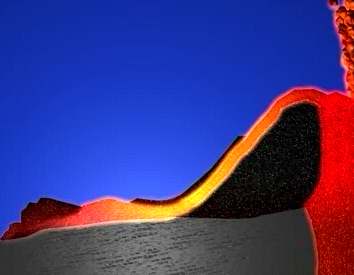Magma is molten rock and the other materials contained within: gases, liquids, solids. Magma reaching the earth's surface is expelled through a volcano. It is a vent from lower regions of the earth.
Lava is a river of molten magma. Magma may also be explosively expelled and be in the form of super heated gases and tiny hot particles.
As with most things in geology, magma too can be characterized and compartmentalized. Three distinct types of magma are more common than all others and are described by the following:
Composition and in particular percentage silica.
Dissolved gases in magma are very important in determining the physical characteristics of the magma. Even at low concentrations 0.2 - 3% they have tremendous effect.
The main gases are H2O, and CO2 (98%)
gases that sometimes achieve 1% are SO2, HCl, N2 and Ar.
|
|
|
|
|
basaltic |
|
|
|
andesitic |
|
|
|
rhyolitic |
|
Temperature of magma is hard to measure, first it is not easy to get near molten magma, secondly the magma cools quickly when removed from its heat source, and thirdly the sensor must survive the measurement.
Magmas tend to be in the range of 1000 C - 1400 C
Viscosity is the measure of flow of a magma, most magmas do not flow very fast, but a few have been clocked at speeds in excess of about 10-15 mph. The more viscous a magma is the slower it flows.
|
|
|
|
|
basaltic |
|
|
|
andesitic |
|
|
|
rhyolitic |
|

A good model for magma coming upward is a bottle of soda pop shaken well then quickly opened. The sudden release of pressure and extra energy placed into the liquid from shaking causes some of the gas in the liquid to come out of solution. This gas being many times less dense than the surrounding liquid rushes to get out of the bottle carrying with it a good deal of the liquid.
We talked about convection in an earlier chapter, and it is convection set up by the heated magma which makes it begin to rise. As a magma gets hotter, it becomes less dense than surrounding cooler rock and begins to rise. If it maintains its heat, it becomes lighter and lighter the further it rises, and as it rises the external pressure also decreases. This makes the escaping gas form bubbles and then the gas expands or builds pressure even faster.
Basaltic magmas tend to move more slowly and have less gas dissolved, so their eruptions tend to be less violent. At the beginning of an eruption there is fast out pouring of gas and fountains are often created for a time. Eventually the magma reaches more of a steady state and issues forth smoothly and without a great deal of energy.
Since it is extremely hot, yet only slightly above the crystallization point of the minerals present within it, it will "skin" rapidly. The outside cools quickly and forms a rock coating. This coating acts like a thermos bottle and maintains the heat inside. This may create a lava tube, a conduit for hot molten lava to travel great distances while maintaining much of its heat.
As it continues to cool and loses more gas, it forms thin tube like structures called "pahoehoe", and eventually slows almost to a halt, it forms rough aa (pronounced ah-ah) flows that barely move. They look a little like black popcorn falling down a very slow moving embankment.
| NEXT | TOC | PREV |